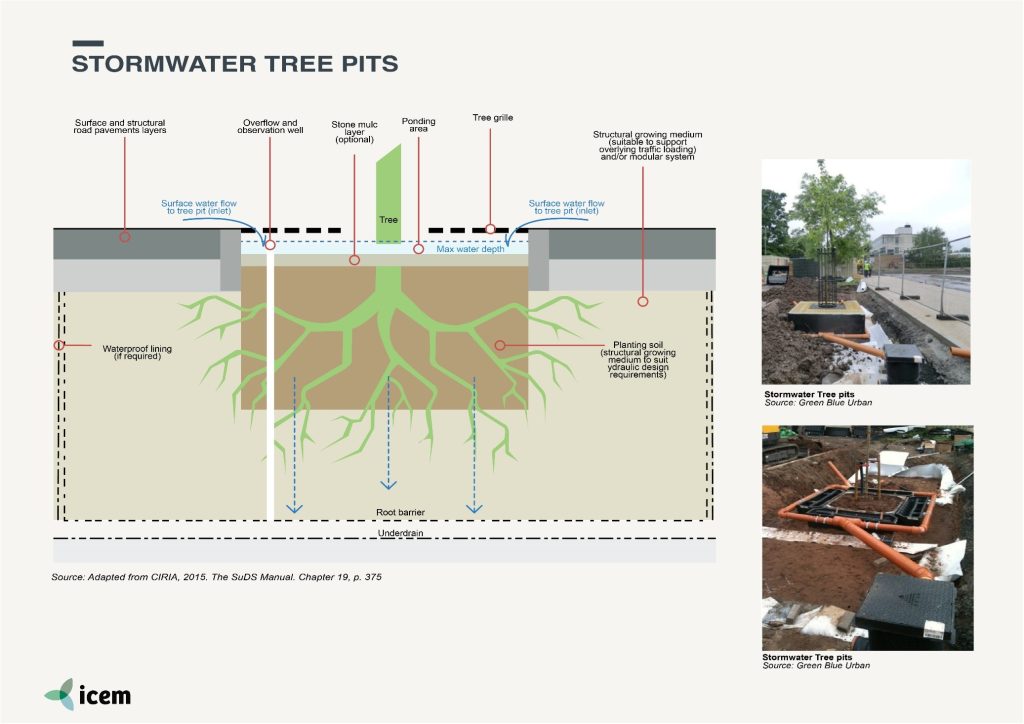| |
||||
| Suburban and urban | Public Spaces | Low-cost | Pluvial/fluvial flooding | |
| DESCRIPTION | |
| Measures
|
A tree pit comprises a tree planted within an underground pre-cast concrete pit that generally consists of a combination of media layers that allows stormwater to slowly infiltrate from the surface down to underdrain pipes where the treated stormwater is then conveyed to a traditional stormwater drainage system. Stormwater tree pits are thus similar to traditional tree planting pits but have more capacity for stormwater runoff. The primary benefits of stormwater tree pits are runoff reduction; enhanced tree growth due to sufficient space, regular irrigation, and improved drainage; and the breakdown of water pollutants through microorganisms in the substrate. Tree pits can be installed individually or together as part of a street redesign and stormwater benefits are maximized when stormwater tree pits are connected with other adjacent stormwater management practices. |
| Location | Tree pits are constructed on the sidewalks or islands or dividers adjacent to paved areas and will have curb inlets and channels to direct stormwater flows to the tree pit. Tree pits can be installed individually or together as part of a street redesign and stormwater benefits are maximized when stormwater tree pits are connected with other adjacent stormwater management practices. |
| Design options and performance | Tree pits improve street tree growth and reduce urban stormwater runoff by providing an engineered growing medium that promotes optimal root growth while increasing runoff infiltration. Their use can significantly reduce the velocity and flow rate of surface water runoff in urban areas and contribute towards lowering the discharge rates while filtering out harmful pollutants and contaminants carried in surface water. They complement the streetscape while providing an attractive and aesthetically pleasing system for treating and minimizing stormwater runoff. Tree pit systems manage surface water at the source and make use of the under-pavement tree root zone soils to provide stormwater treatment. The growing media prevents particles in the water from passing through and allows the water to be discharged into the surrounding subsoil to be absorbed by the trees’ root system or to find its way into the flow-control chamber positioned on the outfall of the tree pit. |
| Feasibility criteria
|
Urban trees reduce stormwater flow by intercepting rainwater on leaves and providing evapotranspiration and shade. Trees are only intended to manage surface water runoff from the local area. They should not be used to manage large volumes of water.
Technical design: Tree pits are constructed on the sidewalks or islands or dividers adjacent to paved areas and will have curb inlets and channels to direct stormwater flows to the tree pit. Tree pits can be constructed on-site but are usually manufactured and will include the following components: ● Plant covers: grate or similar at the base of the tree to protect the roots; ● Ponding area: the area around the tree set lower than the surrounding ground where stormwater ponds before filtering through the soil; ● Mulch layer: prevents weeds and helps soil to stay moist; ● Soil layer: mix of sand, topsoil, and silt (without clay) with good drainage properties; ● Root barrier: geotextile fabric used to line the tree pit and prevent roots from growing outside the pit and damaging utility services, building foundations and roadways; ● Waterproof lining: required in areas of poor drainage to avoid saturating the tree pit or where the groundwater lies close to the ground surface; ● Underdrain: a layer of aggregate in the bottom of the pit to collect water draining through the soil and direct it to the stormwater network; ● Overflow: standpipe to direct higher than normal flows to the stormwater system; ● Observation well: capped riser pipe to monitor water depth and drainage rates in the pit. Discharge and overflow pits may also be fitted with cleanouts and inspection pipes; ● A large shrub or tree is planted inside the tree pit. The species selected should look attractive and be able to withstand extended wet and dry periods. Soil media: prepared mix of sand, topsoil and silt (without clay) Soil slope: n/a Surface cover: In a dry year, trees more significant than 15 m in height required 60–150 m3 of water from the soil during the growing season. Therefore, it is important to ensure that the runoff area draining to the tree provides sufficient water for when it is fully grown. |
| Operations and maintenance | Tree pits require regularly scheduled maintenance to ensure they remain healthy and perform as intended. It is important to regularly inspect the filter media to monitor sediment, gross pollutant and leaf litter accumulation. Additionally, any weeds should be removed, plant health and detention zones monitored and the under-drain system should be periodically flushed out. Maintenance requirements of trees are greatest during the first few years when the tree is becoming established. Early maintenance should involve regular inspection, removal of invasive vegetation, and possibly irrigation during long dry periods, particularly in soils with high void ratios. |
| Cost and benefits | Medium cost measure. Tree pits are an effective and environmentally positive means of managing runoff from roads and other hard-paved surfaces while significantly reducing the volume of pollutants conveyed in the stormwater from reaching the receiving waterways. The primary benefits of stormwater tree pits are (i) runoff reduction; (ii) enhanced tree growth due to sufficient space for roots, regular irrigation, and improved drainage; and (iii) the breakdown of water pollutants through microorganisms in the substrate. |
| Design solution
|
Stormwater street trees use designs that are specially targeted to maximize stormwater absorption and treatment within the tree planting area. In a traditional urban tree pit, tree growth can be limited by the soils in which they are planted; flooding or poor stormwater drainage; surrounding structures such as buildings, utility lines and sidewalks; and improper or lack of maintenance. Stormwater tree pits are designed to help the tree withstand these pressures. They are small-scale stormwater treatment systems that are designed to maximize the stormwater benefits of tree planting and enhance stormwater management overall through the use of design techniques, engineered soils and proper maintenance. The result is a greener neighbourhoods and healthier waterways. Therefore, stormwater tree pits should not be thought of as a direct replacement for traditional street trees because, while the above-ground look may be similar, the stormwater tree pits add value in unseen ways that lead to a cleaner environment overall. |
| Environmental performance | Stormwater tree pits reduce peak runoff flows, increase groundwater infiltration (if underlying soil conditions are appropriate), improve the water quality of local watercourses and improve the health of urban trees. These factors combined help to provide a green and pleasant urban environment while also being a vital part of the municipality’s stormwater management system. |
| Sources | ● Tree City USA Bulletin. 2010. How Trees Can Retain Stormwater Runoff.
● US Environmental Protection Agency. 2016. Stormwater Trees – Technical Memorandum. |
Originally developed under the ADB ‘TA-9417 VIE: Secondary Green Cities Development Project – Output 2: Demonstrated sustainable and resilient development in Hue, Ha Giang and Vinh Yen’. Adapted for the UN-CTCN project ‘Climate risk assessment for subnational adaptation and establishment of a local climate information system for climate change adaptation (LISA) in Cambodia’.



